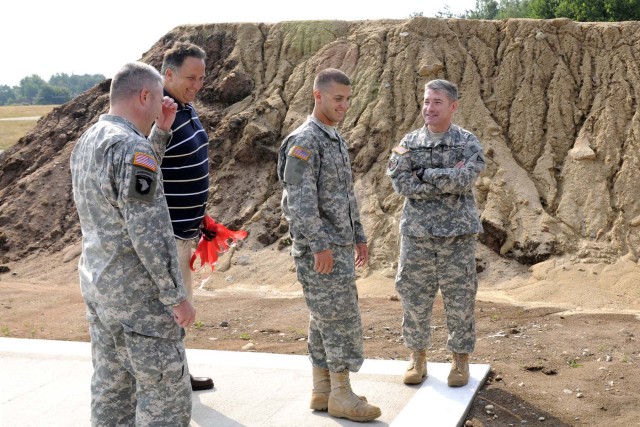GRAFENWOEHR, Germany - The 15th Engineer Battalion recently completed a safety berm at the Grafenweohr Army Airfield (GAAF) in Grafenwoehr, Germany. The troop construction saved the Joint Multinational Training Command (JMTC) more than $51 thousand dollars in construction costs, while the Engineers performed skills that required both vertical and horizontal construction, which they rarely get to do simultaneously.
"We had to stay flexible, and be resourceful to tackle the problems that came up during the project," said 1st Lt. Eric Sears of the 15th Engineer Battalion's, 500th Engineer Company. "The Grafenwoehr Training Area is really huge, and it was built by the Germans, over a swamp. They drained and shifted the water table when they reclaimed the land to build the facilities. The terrain and drainage at this site, and all around the Grafenwoehr Training Area is especially difficult to gauge for this kind of project."
A berm is a mound of earth with sloping sides. After some changes in the initial plan, the final berm consists of a bottom layer of fill material followed by an impervious layer of clay at least 1' 0" thick, and finally the surface layer of good quality topsoil. The slope and shape of the clay layer was adjusted to ensure the drainage was sufficient for this area before the topsoil layer was added, he said.
"If we have a situation for example where a Apache AH-64 tries to fire a rocket, while training over Graf, and that rocket doesn't respond, said Steve Shaw, airfield manager. "We need to be ready to help them to disarm, quickly and effectively. The berm acts as a safety clearing barrel for any weapons that are not doing what they should on a helicopter."
The newly completed berm will contain a 30mm round, and stop a Hell-fire missile in the event of negligent discharge. It won't allow a Hell-fire missile to travel to arming distance.
The relocation of the de-arm berm has enhanced the safety of the airfield. It provides a safe place to disarm aircraft after an in-flight emergency, or if the aircraft is unable to return to the range complex because of mechanical failure.
The newly designed pad also provides a safer working environment for disarmament crews. The cement pad is smooth and flat, as opposed to the uneven grassy area that was part of the old de arm area.
"Today, through the efforts of these Soldiers, the Joint Multinational Training Command (JMTC) scored a triple win." said Col. Michael S. Higginbottom, JMTC's Chief of Staff, as he addressed the Soldiers of the 15th Engineer Battalion and members of the Grafenwoehr Military Community from a podium on the flightline of the GAAF.
"First and foremost the construction of this berm makes the airfield a safer place to deal with helicopter emergencies and weapons contingencies, second it allows for wider Mission Essential Task List training possibilities, and third it was constructed at significant savings to the U.S. Army; that's a triple win." said Higginbottom.
Grafenwoehr's Department of Public works originally estimated the construction costs of the berm by a private contractor at more than 60,000 Euros.








Social Sharing